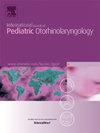Ketorolac does not increase postoperative hemorrhage and limits narcotic use in pediatric patients undergoing intracapsular tonsillectomy
IF 1.2
4区 医学
Q3 OTORHINOLARYNGOLOGY
International journal of pediatric otorhinolaryngology
Pub Date : 2025-05-19
DOI:10.1016/j.ijporl.2025.112400
引用次数: 0
Abstract
Background
Conflicting evidence regarding the safety of perioperative ketorolac in children undergoing intracapsular tonsillectomy has led to some providers avoiding the use of ketorolac. However, emerging evidence indicates that ketorolac may be a safe option for pain control in these patients.
Methods
We conducted a single-center retrospective cohort study of children undergoing intracapsular tonsillectomy. Exposures were children who received perioperative pain control with ketorolac compared to children who did not receive perioperative pain control with ketorolac. The primary study outcome was post tonsillectomy hemorrhage (PTH) requiring operative control. Secondary outcomes were post operative pain readmission, time spent in the PACU, and opioids administered in the PACU.
Results
1594 patients fit inclusion criteria; 743 received ketorolac (46.6 %) and 851 did not receive ketorolac (53.4 %). There was no difference in rate of PTH requiring operative control in patients who received ketorolac compared to patients who did not (0.7 % vs 1.4 %, Chi-square test, p = 0.1415). There was no difference in the rate of postoperative pain readmission between the two groups (2.0 % vs 3.1 %, Mid-P test, p = 0.167). The median time spent in the PACU was 13.4 % less in the ketorolac group (48 min vs 58 min, multivariate linear regression, p < 0.001). The mean total opioid dose given in the PACU was significantly less in the ketorolac group (3.7 morphine milligram equivalents (MME) vs 5.3 MME, t-test, p < 0.001).
Conclusion
In this cohort of children undergoing intracapsular tonsillectomy, there was no difference in the rate of PTH requiring operative control in children who received perioperative ketorolac compared to children who did not receive perioperative ketorolac. In addition, children who received ketorolac received lower total amonuts of opioids in the perioperative period and spent less time in the PACU. Further prospective, randomized clinical trials are necessary to confirm the impact of ketorolac in this population.
酮罗拉酸不会增加术后出血,并限制小儿扁桃体囊内切除术患者麻醉的使用
背景:关于儿童囊内扁桃体切除术围手术期使用酮咯酸的安全性的相互矛盾的证据导致一些提供者避免使用酮咯酸。然而,新出现的证据表明,酮罗拉酸可能是控制这些患者疼痛的安全选择。方法对接受囊内扁桃体切除术的儿童进行单中心回顾性队列研究。暴露于接受酮罗拉酸围手术期疼痛控制的儿童和未接受酮罗拉酸围手术期疼痛控制的儿童。主要研究结果是扁桃体切除术后出血(PTH)需要手术控制。次要结局是术后疼痛再入院、在PACU中度过的时间以及在PACU中使用阿片类药物。结果1594例患者符合纳入标准;743例(46.6%)接受酮罗拉酸治疗,851例(53.4%)未接受酮罗拉酸治疗。接受酮洛酸治疗的患者与未接受酮洛酸治疗的患者相比,需要手术控制的PTH发生率无差异(0.7% vs 1.4%,卡方检验,p = 0.1415)。两组术后疼痛再入院率无差异(2.0% vs 3.1%,中间p检验,p = 0.167)。酮洛酸组PACU中位时间减少13.4% (48 min vs 58 min,多元线性回归,p <;0.001)。酮洛酸组在PACU中给予的平均总阿片类药物剂量明显更少(3.7吗啡毫克当量(MME) vs 5.3 MME, t检验,p <;0.001)。结论:在接受囊内扁桃体切除术的儿童队列中,围手术期接受酮罗拉酸治疗的儿童与未接受酮罗拉酸治疗的儿童相比,PTH需要手术控制的比例没有差异。此外,接受酮罗拉酸治疗的儿童在围手术期接受的阿片类药物总量较低,在PACU的时间也较短。需要进一步的前瞻性随机临床试验来证实酮罗拉酸对这一人群的影响。
本文章由计算机程序翻译,如有差异,请以英文原文为准。
求助全文
约1分钟内获得全文
求助全文
来源期刊
CiteScore
3.20
自引率
6.70%
发文量
276
审稿时长
62 days
期刊介绍:
The purpose of the International Journal of Pediatric Otorhinolaryngology is to concentrate and disseminate information concerning prevention, cure and care of otorhinolaryngological disorders in infants and children due to developmental, degenerative, infectious, neoplastic, traumatic, social, psychiatric and economic causes. The Journal provides a medium for clinical and basic contributions in all of the areas of pediatric otorhinolaryngology. This includes medical and surgical otology, bronchoesophagology, laryngology, rhinology, diseases of the head and neck, and disorders of communication, including voice, speech and language disorders.

 求助内容:
求助内容: 应助结果提醒方式:
应助结果提醒方式:


